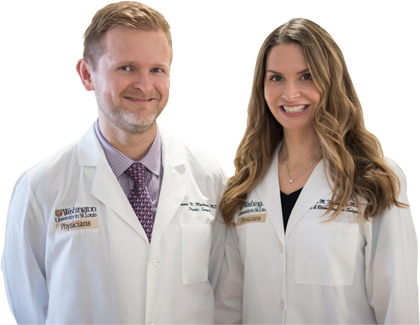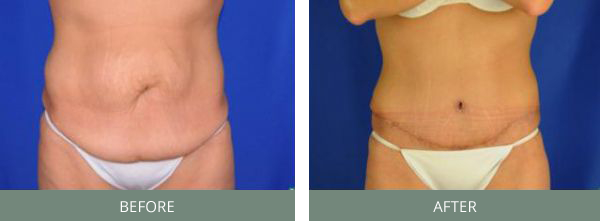BREAST AUGMENTATION IN ST. LOUIS
Among breast augmentation specialists in St. Louis, board-certified plastic surgeons Dr. Terry Myckatyn and Dr. Marissa Tenenbaum understand that women choose to have breast enlargement surgery for many different reasons. Whatever the reason for feeling dissatisfied with their breast appearance, at West County Plastic Surgeons of the Washington University School of Medicine, we take great care in evaluating our patients' needs and goals to ensure a beautiful cosmetic result. Safe and satisfying outcomes are our primary goal, and we strive to ensure the best possible end results for every patient.
The surgeons and staff of our practice understand that breast augmentation involves much more than simply choosing and inserting breast implants. When surgical skill is paired with a clear understanding of each patient's needs and expectations, breast enlargement can lead to increased personal satisfaction and self-confidence.
At the office of West County Plastic Surgeons, our breast augmentation patients have access to leading innovators in the field of plastic surgery. Dr. Myckatyn serves as Director of Cosmetic and Breast Plastic Surgery at Washington University School of Medicine, specializing in all forms of cosmetic surgery and breast reconstruction. Dr. Tenenbaum performs all forms of cosmetic surgery and breast reconstruction, employing techniques acquired through working with some of the most respected cosmetic and reconstructive surgeons in the country. Our practice offers a patient-friendly atmosphere and a university medical-school reputation for cutting-edge techniques and technologies that lead to optimal results and patient satisfaction.
To schedule your consultation for breast enhancement, contact our St. Louis office by phoning (314) 996-8800, requesting your consultation online, or emailing us today.
Breast Augmentation with Implants: What You Should Know
Before having a breast implants surgery at our St. Louis practice or elsewhere, patients should educate themselves about the following decisions they will make with their surgeon:
Incision location. Most breast implant patients have three common incision options: 1) under the breast, 2) under the areola (the pigmented circle surrounding the nipple), or 3) in the armpit. An incision under the breast, or the inframammary fold (IMF), is typically an excellent choice for patients who do not also require a breast lift. Incisions under the areola work well for any patient undergoing a breast lift, or who has moderate to large areolas. For this option, the surgeon places the incision along the lower curve of the areola, easily concealing it in the areolar border. Our breast augmentation patients who have a relatively small areola and desire a moderate-sized or larger silicone implant are not candidates for this periareolar approach. The armpit, or transaxillary approach, uses a short scar concealed in the armpit. We typically reserve this approach for patients who have not had previous breast augmentation, do not require a breast lift, and prefer a saline implant.

Implant positioning above or below the chest muscle. When placing breast implants, our patients have two options: above or below the chest (pectoralis) muscle. In general, implants are placed under the pectoralis muscle if the patient has only a modest amount of tissue thickness above the nipple. This helps achieve a more natural slope to the upper breast and reduces premature hardening of the pocket surrounding the implants, also known as capsular contracture. Patients may choose to place breast implants above the muscle if they are extremely athletic, have additional pre-existing breast tissue above the nipple to help camouflage the implant, or intentionally wish to have a more discrete, implanted look in the upper chest.

Implant size. It is always helpful to have a sense of the desired breast implant size when consulting with a surgeon for breast enlargement. The St. Louis office of West County Plastic Surgeons of Washington University now offers the VECTRA 3-D imaging system to help patients visualize their results following surgery.

Dr. Terry Myckatyn and
Dr. Marissa Tenenbaum:
Trusted. Experienced. Committed.
The VECTRA 3-D imaging system captures a 180-degree image of each patient, and a computer program then creates a picture from it. Using this image, patients then work with Dr. Myckatyn or Dr. Tenenbaum to “try out” various implant sizes to see how they will look following surgery. The VECTRA 3-D system also allows patients to view images from a variety of angles, and it offers side-by-side comparison with one's current appearance. The VECTRA 3-D system provides a powerful tool for providing visual answers for many of our patients who have questions about their breast augmentation results.
In addition to the VECTRA 3-D system, our office has many photographs of prior breast augmentation patients who have undergone breast enhancement using a wide variety of breast implant sizes.
When choosing the size of breast implants, we advise our breast enhancement candidates to review “before and after photos” of patients taken using standardized poses. We also recommend that our patients review photos of other patients whose pre-surgical size and shape closely resemble their own for the best idea of what to expect following surgery. We advise patients to bring to their consultation photos of positive and negative results. When surgeons know what their patients do not like, they can make a concerted effort to avoid those results help patients formulate realistic expectations.
Implant type: saline versus silicone. Breast implants are filled with either saline or silicone gel. Our bodies contain more than 60% saline, a salt water solution. Therefore, if a saline implant ruptures, the implant rapidly deflates and the body easily reabsorbs the saline solution. Silicone implants are filled with a cohesive silicone gel that helps these implants maintain their shape and have a more natural feel than saline implants. In November 2006, the FDA reapproved silicone implants for use in patients 22 years of age or older. Since silicone implants do not rapidly deflate if there is a leak, the FDA recommends that patients with silicone implants have periodic MRI exams to confirm the integrity of their implants. The shells of both saline and silicone implants are made from an elastomer consisting of polydimethylsiloxane, which is made more durable at room temperature. These implants can be smooth or textured. Click here to join our blog discussion on the benefits and drawbacks of silicone versus saline breast implants for our patients.
Breast implants and breast cancer. Breast implants do not increase or decrease one's risk of developing breast cancer. Breast implants do, however, affect how mammograms are taken. In general, if patients do not have a first-degree relative (parent or sibling) with breast cancer, they should have their first screening mammogram or breast X-ray at 35 years of age. If the results are normal, we recommend that they proceed to annual screening mammograms starting at 40 years of age. In general, two pictures of each breast are taken during screening mammography. However, patients with breast implants require that additional displacement views be taken to show the implants displaced or pushed out of the way, sometimes referred to as “Eklund maneuvers.” We advise our breast implants patients from St. Louis to schedule their mammograms at a facility familiar with this technique. Alternatively, an MRI can be used to evaluate the breasts. In general, breast tissue is easier to visualize with mammography if implants are placed under the pectoral muscle (subpectoral or bi-planar) instead of above the muscle (subglandular).
How often should breast implants be replaced? Breast implants are not perfect and will eventually fail. The two main reasons are a leak or rupture, or capsular contracture causing the pockets surrounding the implants to become hard and painful. The average lifespan of a breast implant – saline or silicone – is 10 to 15 years. So, although breast implants are very safe medical devices, they will eventually need to be replaced. In some cases, because of the natural process of aging, gravity, and the weight of the breasts, replacement of breast implants may be accompanied by a breast lift procedure.
Before & After
Visit our Photo Gallery to see our patient results.
*Results may vary.
View Patient ResultsIt is also important to know that the major breast implant companies – Allergan and Mentor – provide excellent warranties with their breast implants and will cover device replacement as well as some of the subsequent surgical fees.
Deciding between a breast augmentation, breast lift, or both. A breast augmentation will add volume and size to the breast. Larger breast implants can also raise nipple position by 1 to 2 cm, thus effectively providing a modest breast lift. Women who only want their breasts to appear more “perky” and raise their nipples, but not necessarily have larger breasts, are better candidates for a breast lift (mastopexy). A combination breast lift and breast augmentation, or augmentation mastopexy, is best suited for women who want their breasts to be perkier, but with more fullness in the upper pole of the breast and more volume. In these cases, a breast lift alone cannot achieve as much upper-pole fullness as augmentation mastopexy, so an implant is used not just to gain size, but to achieve a certain shape.
Click here to view a video on breast augmentation.
Anesthesia: A breast augmentation is usually performed in our surgery center with the patient under general anesthesia.
Length of procedure: 45 to 60 minutes.
Estimated recovery time: Patients can return to work after 3 to 5 days, and they should avoid vigorous activities for 3 weeks. Visible bruising should subside within 1 week, and swelling should begin to resolve within 3 weeks. To learn how to prepare for a breast enlargement surgery at our office and what to expect afterwards, click here to download our patient instructions.
Side effects: Common side effects include bruising and swelling. Click here to download a detailed consent form from the American Society of Plastic Surgeons that lists the risks and benefits of breast augmentation with saline implants or breast augmentation with silicone gel implants.
Before-and-after photos of breast augmentation results: Click here
Procedures That Complement Breast Augmentation
Many of our patients choose to combine breast augmentation with one or more of the following procedures to achieve optimal aesthetic results:
- Breast lift (mastopexy). Patients with excess breast skin and downward-pointing nipples may wish to consider a breast lift (mastopexy) to raise the breast tissue and nipples to a more youthful position. This is particularly common in individuals who may be candidates for an extended abdominoplasty because weight fluctuations in these individuals often leads to redundant skin of the breasts, abdomen, and flanks.
- Simultaneous breast augmentation and breast lift (augmentation mastopexy). Some patients may benefit from adding breast volume, tightening the breast skin, and repositioning the nipples to a more youthful position, which is best achieved with a combination breast lift and augmentation, also known as an augmentation mastopexy. This combination is also particularly common in individuals who may be candidates for an extended abdominoplasty because weight fluctuations in these individuals often leads to volume loss and redundant skin of the breasts, abdomen, and flanks.
- Liposuction. Removal of fat from the sides, thighs, back, and buttocks with standard tumescent liposuction, ultrasonic-assisted liposuction, or SMART laser-assisted liposuction provides a nice complement to refinement of the abdomen with an abdominoplasty.
- Abdominoplasty (tummy tuck). Frequently, patients wishing to improve the contour of their abdomen debate between an abdominoplasty or tummy tuck and liposuction. Some individuals can be candidates for either procedure, depending on their goals. An abdominoplasty is best for people with loose skin and lack of abdominal muscle tone who have undergone significant weight loss or for women who are dissatisfied with their shape after having had children and are looking for a so-called “mommy makeover.”
Combining breast lift and breast augmentation with other procedures can be performed efficiently and safely. Click here to read Dr. Tenenbaum's article on combining breast surgery and abdominoplasty.
To schedule your consultation for a breast augmentation, contact our St. Louis office by phoning (314) 996-8800, requesting your consultation online, or emailing us today.
If you have questions or would like to book a consultation with one of the surgeons at West County Plastic Surgery, please call (314) 996-8800.














